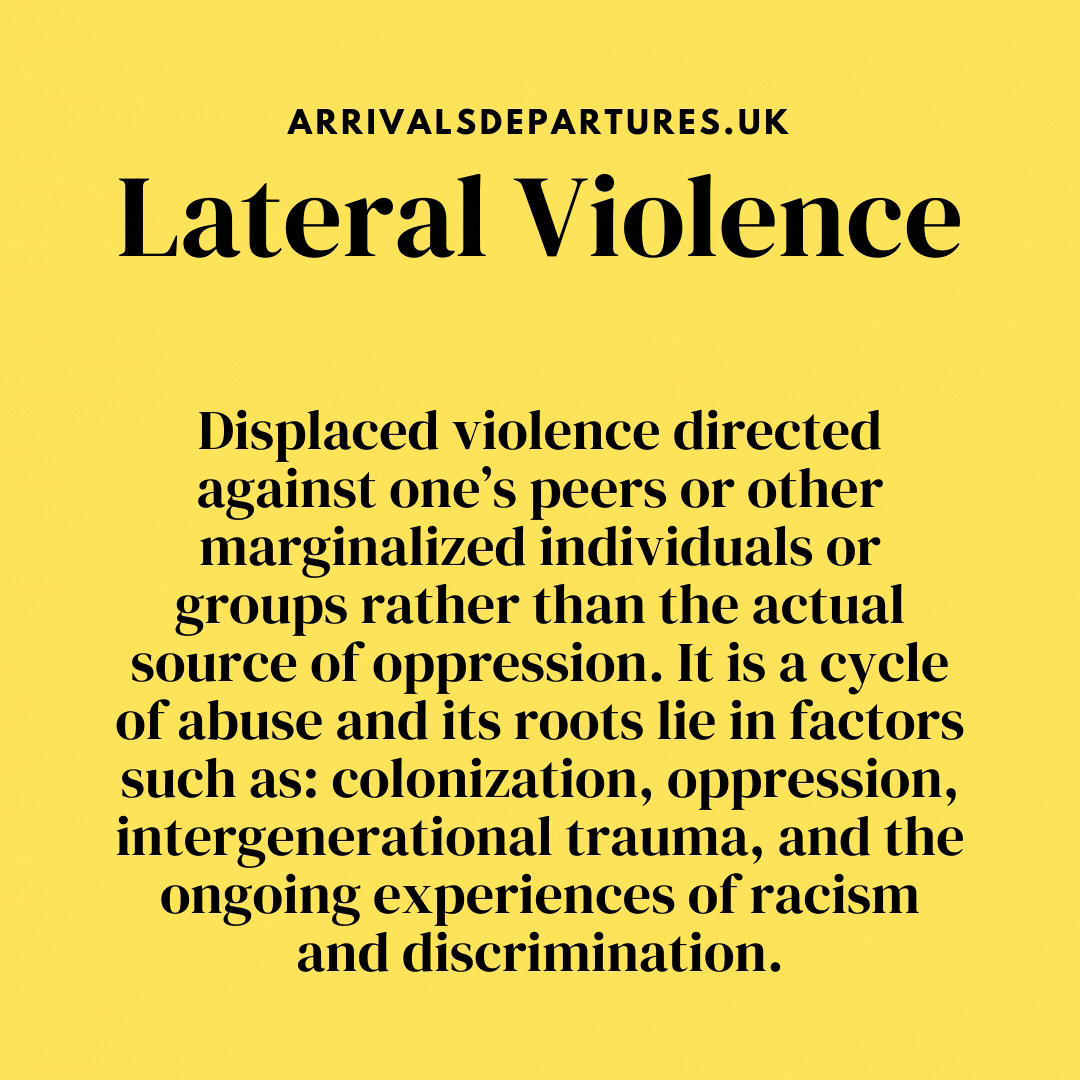Lateral Violence
When microaggressions, systemic abuse, and direct violence comes from other marginalized individuals or groups.
If you belong to a marginalized group - essentially any aspect of your identity that doesn’t conform to dominant culture - the chances you’ve experienced lateral violence are probably high.
WHAT IS LATERAL VIOLENCE?
Lateral violence could be defined as the displaced violence directed against one’s peers or other marginalized individuals or groups rather than the actual source of oppression. According to the Canadian Race Relations Foundation, lateral violence is a cycle of abuse and its roots lie in factors such as:
Colonization
Oppression
Intergenerational Trauma
Ongoing experiences of bigotry
EXAMPLES OF LATERAL VIOLENCE
Lateral violence can also be defined as non-physical, aggressive, hostile, and/or harmful behavior between marginalized peers, coworkers, and other social support circles. Some examples are:
• Engaging in slander, gossip, or other forms of defamation directed at other marginalized individuals or groups.
• Indirect or direct threats that could impact someone personally and or professionally.
• Microaggressions meant to discredit or belittle others, cause harm, or otherwise disempower another marginalized individual.
• Micromanaging or ostracizing, personally and/or professionally.
• Nonverbal communication that expresses unfounded contempt, aggression, or threatening behavior (i.e. eye-rolling, aggressive physical contact, etc).
BASIS OF LATERAL VIOLENCE THEORY
While there are a few theories that explain the foundations of lateral violence, one example that could be used is Paulo Freire’s model from Pedagogy of the Oppressed.
Freire described how an oppressed group or person can internalize traits, values, and cultural norms of the dominant group - thus adhering to what is deemed institutionally and socially acceptable. In turn, an oppressed group or individual can also internalize negative aspects of dominant culture and inflict harm on those who are peers or further marginalized for social and/or financial capital.
As the oppressed group attempts to acquire capital, a sense of self-loathing and fragile ego takes place of a genuine identity. These negative traits are also quite common in Personality Disorders.
While in some cases, oppressed groups can resent the dominant group, they tend to act out against others who lack the real or perceived social and/or financial capital to fight back. In short, it is a cycle of abuse perpetuated toward more vulnerable people instead of directly addressing the roots of injustice.
Sometimes it’s members of one’s own group, and others, it’s other marginalized individuals or groups. Lateral violence is the result, and manifests from an inward frustration of power imbalances as a displaced reaction toward others that affect agency, self-worth, and social/financial capital. of marginalized people.
EFFECTS OF LATERAL VIOLENCE
While lateral violence can appear, at times, to resemble adolescent behavior, the results and long-term impact are troubling. Individuals who are victimized through lateral violence are more susceptible to anxiety, depression, professional burnout, and an increased risk of suicidal ideations.
WHAT YOU CAN DO ABOUT LATERAL VIOLENCE
Whether you experience lateral violence personally or are witness to it, it’s important to document all aspects of any incidents to include names, dates, times and any additional information pertaining to ongoing abuse. Stigma’s power lies in silence, and lateral violence is no exception.
Lateral violence may be inflicted through subtle microaggressions or escalate to far more aggressive tactics, but it’s important to maintain documentation and to get external assistance - especially if this is related to workplace incidents of lateral violence. Also, be sure to avoid insinuating the intent of the perpetrator and do your best to use concise descriptions based on what was experienced or witnessed.
Often, it’s advisable to engage with a mental health professional or mediation professional to determine the best course of action to follow through on ensuring the abuses made through lateral violence ends.
More importantly, if you witness a marginalized individual experiencing lateral violence, remain calm and engage in offering help. If this is being done in a professional setting, assist the individual in following chain-of-command procedures in conflict resolution. This could include addressing lateral violence in staff meetings, obtaining education and training in lateral violence, and following through to ensure the person who was targeted is safe.



